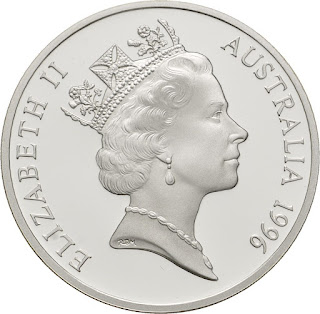Commemorative coins of Australia 5 Dollars Silver Coin 1996 Dame Nellie Melba
Obverse: Crowned bust of Queen Elizabeth II right.
Obverse Designer: Raphael Maklouf
Reverse: Bust of soprano Dame Nellie Melba, with large hat, 3/4 facing, at right, drape, inscription and value at left.
Reverse Designer: Wojciech Pietranik.
Composition: Silver.
Fineness: 0.9250.
Weight: 35.79 grams.
ASW: 1.0643 oz.
Size: 38.9 mm.
This piece is a commemorative coin, which pays tribute to the contributions made to Australian culture by the singer Dame Nellie Melba. This particular coin is just one out of a set of five $5 proof coins, all which were struck into sterling Silver. Australia is a country of rich culture there are people and events that have contributed to making it so. Each coin celebrates the achievements or effects of significant people and pastimes which have helped to shape the national Identity that Australia holds proud today. Those chosen to feature on the coins are believed to have played an important role in inspiring and motivating others on both an individual basis and a national one. Joining Dame Nellie Melba in this collection of people and pastimes that helped shape Australia are Henry Lawson, Tom Roberts, The Stockman and horse racing. Together they make up a set known as 'Shaping National Identity', which was released in 1996 from the Masterpieces in Silver collection struck by the Royal Australian Mint.
This coin struck in sterling silver had the reverse designed by Wojciech Pietranik, who has worked regularly on the Masterpieces in Silver collections for the RAM. Dame Nellie Melba herself is featured on the reverse and the legend, her name Dame Nellie Melba has been stylized in such a way to suggest that it is being sung. This is of course intended to represent her tremendous contributions to Australian culture as a popular singer. An additional legend reads 5 DOLLARS . The obverse of the coin features the traditional Maklouf effigy of Her Majesty Queen Elizabeth II and the legend ELIZABETH II AUSTRALIA 1995 curls around the edge. This coin was packaged along with 4 others to create the complete "Shaping National Identity" set, originally came in the simple black box which is a staple of the Masterpieces in Silver Collection. A Certificate of Authenticity came with the set, which includes a short description of the coins and information regarding the designers and sculptors. An extract from the certificate reads 'Each of the five coins are struck on specially prepared blanks using hand-polished dies, following the Mint's strict quality guidelines. The finished product is a mirror-like flat surface complemented by a delicately frosted raised design.'
Nellie Melba
Dame Nellie Melba (19 May 1861 – 23 February 1931), born Helen Porter Mitchell, was an Australian operatic soprano. She became one of the most famous singers of the late Victorian era and the early 20th century. She was the first Australian to achieve international recognition as a classical musician. She took the pseudonym "Melba" from Melbourne, her home town.
Melba studied singing in Melbourne and made a modest success in performances there. After a brief and unsuccessful marriage, she moved to Europe in search of a singing career. Failing to find engagements in London in 1886, she studied in Paris and soon made a great success there and in Brussels. Returning to London she quickly established herself as the leading lyric soprano at Covent Garden from 1888. She soon achieved further success in Paris and elsewhere in Europe, and later at the Metropolitan Opera, New York, debuting there in 1893. Her repertoire was small; in her whole career she sang no more than 25 roles and was closely identified with only ten. She was known for her performances in French and Italian opera, but sang little German opera.
During the First World War, Melba raised large sums for war charities. She returned to Australia frequently during the 20th century, singing in opera and concerts, and had a house built for her near Melbourne. She was active in the teaching of singing at the Melbourne Conservatorium. Melba continued to sing until the last months of her life and made a legendary number of "farewell" appearances. Her death, in Australia, was news across the English-speaking world, and her funeral was a major national event.

